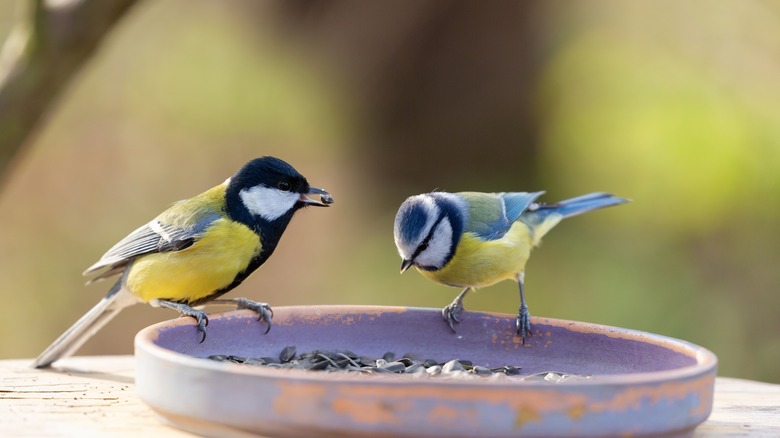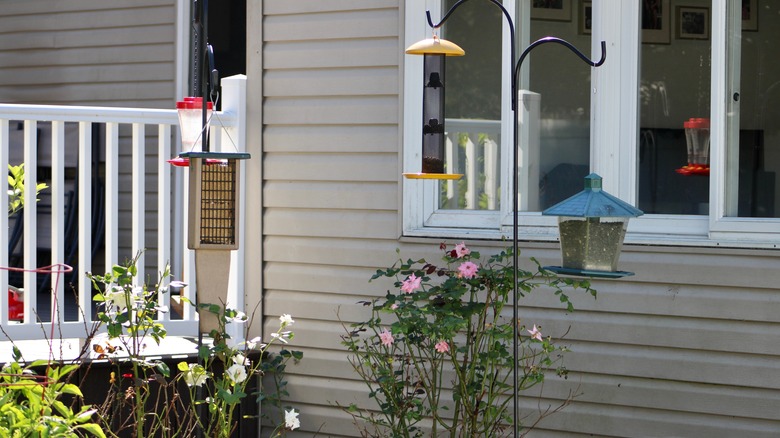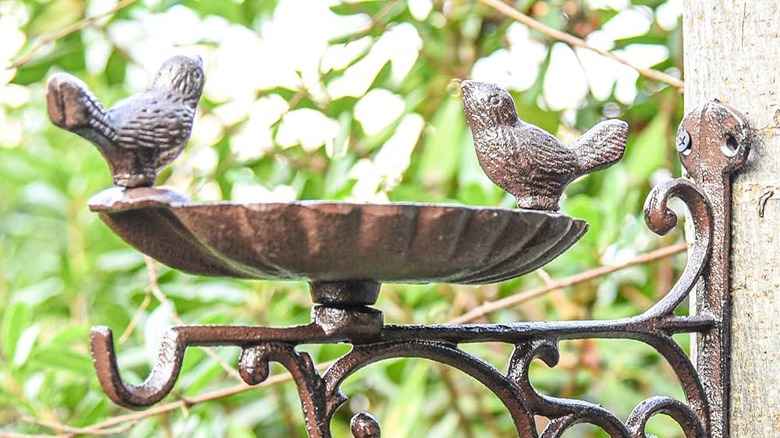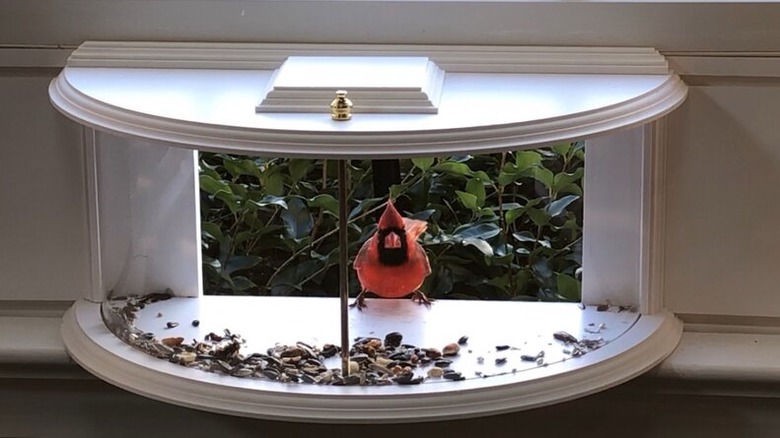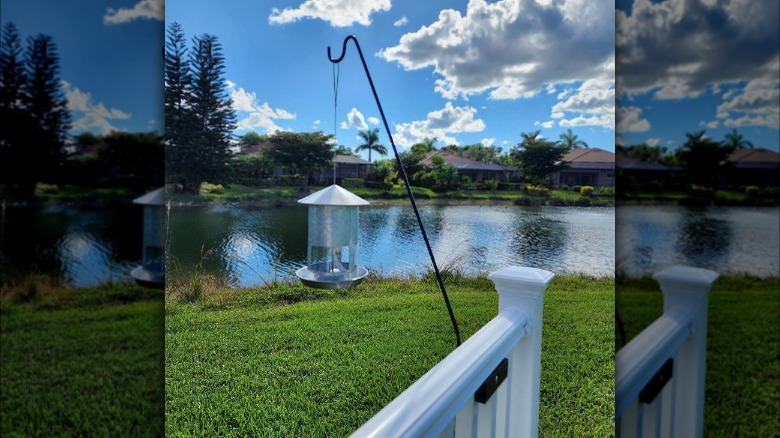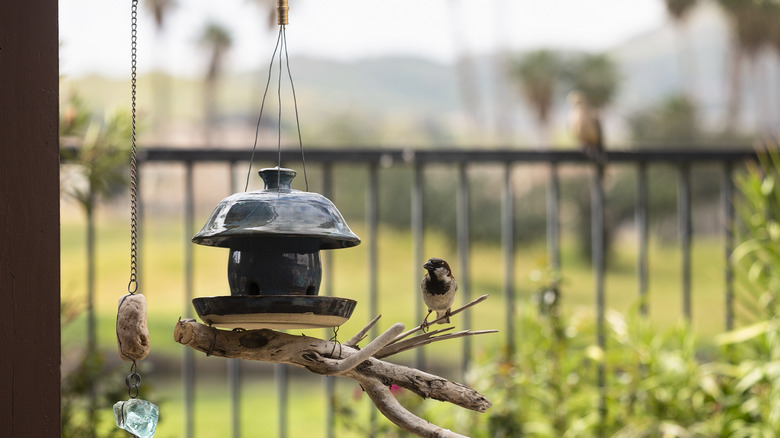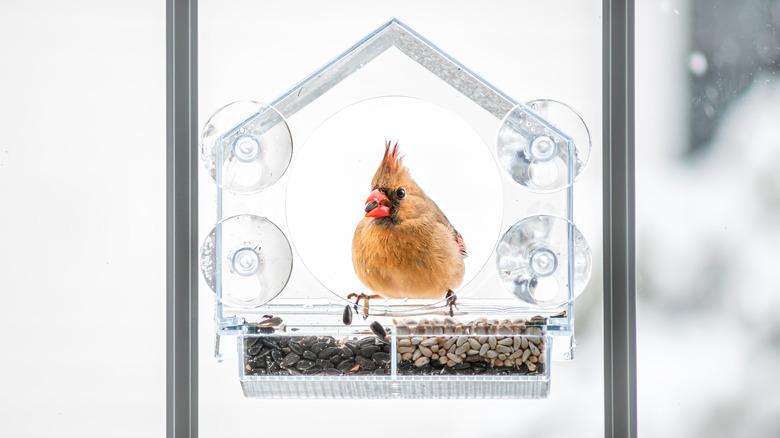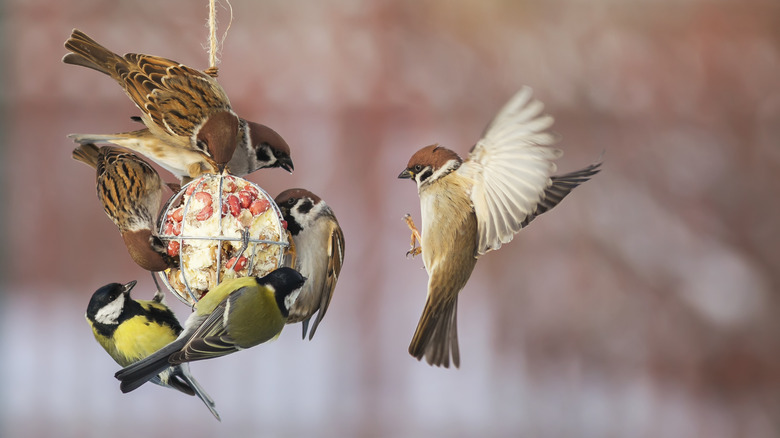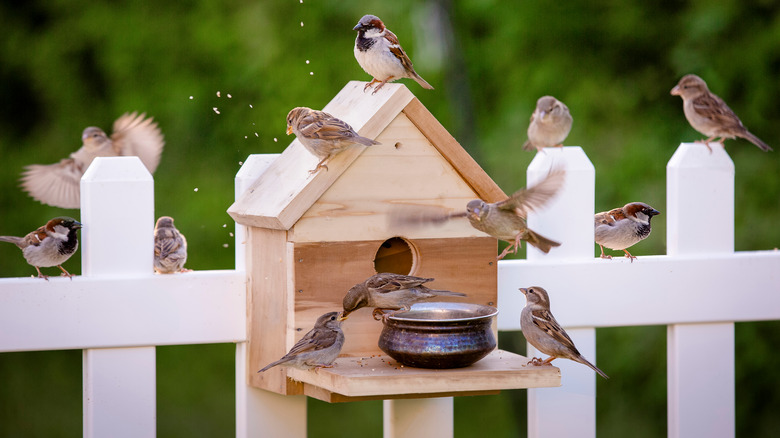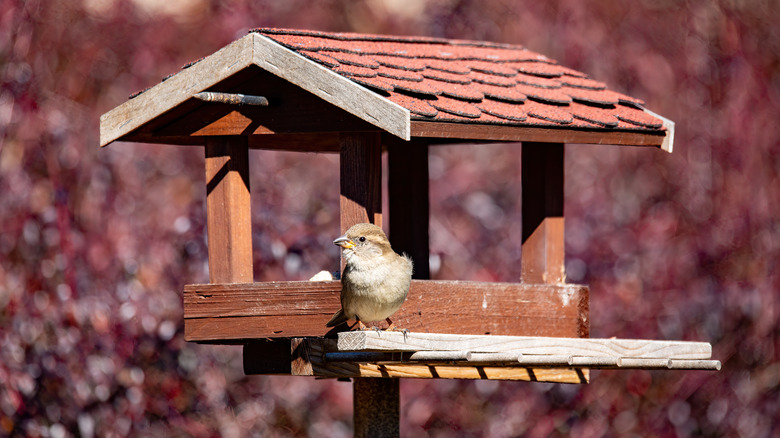Unique Alternatives For Hanging A Bird Feeder Without Having A Tree Outdoors
We may receive a commission on purchases made from links.
If you want to attract birds to your lawn and garden, a feeder with a free meal is the best way to entice their visits. Many times, a sturdy, mature tree is the perfect spot to hang a bird feeder to draw in feathered friends. But what's a bird lover to do if their yard lacks mature hanging branches or any trees at all? How can you provide those hungry flyers with a safe and convenient spot to snack on their favorite seeds?
Luckily, there are many different ways to put bird feeders up around your home, no matter your situation. There are options from permanent, to semi-permanent, to easily removable, and they're all possible to put up yourself. You can use various poles and strings or even your current walls, windows, and fences. All you have to do is find what works best for your home and your bird visitors, and you'll soon have them stopping by to graze.
Bird feeder poles
For those with yard space, bird feeder poles are a great option. You can put them up just about anywhere, so unlike with trees, you can choose their location. These are semi-permanent options as you can easily pull them up out of the ground to remove or relocate them. These are great for areas where there isn't a lot of wind and rain; dry and hot climates especially. If it's very sunny where you set your poles up, seed feeders are best, as too much heat can spoil your hummingbird nectar.
One of the benefits of bird feed poles is that most will come with instructions telling you how much weight they can handle, so you don't need to guess if your feeder is too big or heavy. Feeders on poles are also really easy to remove in order to re-fill them or put them away during bouts of bad weather. There are options out there specifically designed to deter squirrels and other pests that might take advantage of your bird feed before your feathered friends can get to it. You can find these online, in bird supply stores, and at most home improvement or hardware stores.
Wall-mounted
There are plenty of feeders that you can nail directly to an exterior wall, but the easiest and most convenient wall-mounted feeder is any hook you can attach to a wall. There are plenty that are designed specifically with feeders in mind, but plant hangers can work just as well so long as they can bear the weight. For damage-free hanging, there are even some outdoor Command Hooks that are rated for enough weight to hold small bird feeders.
These are perfect for areas that see a lot of wind, as they won't knock over easily. Open-top feeders can collect rain and cause your feed to mold, so rainier climates should have rain-resistant feeders with tops. These are great for people that don't have any lawn space as they can be mounted nearly anywhere like a second-story balcony. With the wide variety of styles on the market, these feeders can look almost decorative and add a lot of charm to your exterior. Some wall-mounted feeders even have smart cameras so you can observe the birds up close from your phone's app as they dine.
In-house window boxes
For those in apartments, any bird feeder on the exterior of their home may not be possible. Fear not. There's a way to bring the birds closer to your home than ever before with an interior window feeder. While there are permanent inserts, many simply go into the bottom of a window, where they can later be removed. These allow you not only to bring the birds right up to your window, but within your actual home, where you can watch them eat, preen, and sing. These are perfect for homes in urban settings where birds are more used to human activity and will be less fearful of visiting. Best of all, these work great in almost all climates; just be aware that in humid areas, your glass can fog, which may obscure your view of the birds.
These tend to be on the pricier side of bird feeders, but the results are well worth it. On most, you can simply remove a little cap from the top of the feeder and pour your seed in, making it one of the easier bird feeder models to refill. Those who like to photograph or closely observe their birds will also find this model to be advantageous with how close you can get to them. For those with pets, consider how they will react to birds being so closely available before you purchase this type of feeder.
Deck and porch hangers
For those with deck or porch space, a great option is a hook to suspend your feeder just past your railing. While most of these will require you to screw the hanger in, there are some clamp-on ones for those who don't want their feeders to be permanently installed. While they do make tons of these hangers specifically for bird feeders, you can find plenty of similar hooks in the gardening section of most hardware or home improvement stores. For those who don't like the hook option, you can find other deck and porch feeders that sit on the top of the railing or attach directly to the posts.
Make sure to check to see if the hooks are rated for the weight of your full bird feeder, and keep your reach in mind. While it may be easy to put it up the first time, you'll need to make sure you can access the feeder when it's time to re-fill it later. Or, hang a suet cage from the hook. This is much quicker to refill and creates less mess, ideal since it's so close to your outdoor living space.
Hang from your eaves
If you want to hang a feeder down from something but don't have a covered porch to do so, the eaves of your home can still offer some protection. Usually, this is as simple as installing a ceiling hook. If you have a metal surface under your eaves, you can also opt for an easy-to-hang rust-free magnetic hook. You can find different types for different materials and weights, so have your location and type of feeder in mind before you make your hook purchase.
Once the hook is up, it's a simple enough matter to hang the feeder. If you find that your feeder's attachment isn't long enough to hang to your desired height, you can usually find wire or lengths of chain to make up the difference. Be aware of anything else you may have hung from your eaves as well like large wind-chimes or light catchers. These could potentially hit your feeder in the wind or scare away your birds by being too flashy. This is a great location for hummingbird feeders, as it will offer shade to stop your sugar solution from spoiling in the sun and protection from the wind, which can cause your feeder to spill.
Suction-cup window feeders
One easy and extremely entertaining option for bird feeders is suction-cup window feeders. You can easily move these as many times as you need to, and their clear backing makes it easy to see the birds from inside. Because of their size and easy removability, you can also wash these off in your sink when needed.
Like the window insert, these clear suction-cup feeders are great for photography and learning about different species. However, if your windows have full screens, they won't work. You also have to consider how easy it is to access your windows. While it may be easy for some people to lean around a wall or open a window to put it on, some apartment or multi-level home layouts may make it dangerous to put this type of feeder up. Be aware that too much activity behind your windows can keep birds from visiting these locations as often, so choose a quiet room in your home.
You should also be especially aware of your glass. Large windows without frames can be hard for birds to see. So, if you're attracting birds to your window, select one that will make it less likely for them to injure themselves by flying into the glass. You can also use reflective window stickers to help with visibility if this is a concern.
Hang from the ceiling
If you have any outdoor ceilings, like covered porches, decks, or entryways, you can hang bird feeders directly from the ceiling. You can use rust-resistant metal hanging hooks that screw securely into the ceiling joists. If you have exposed beams, you can also swing rope or wire over the top to attach a feeder to them. Keep in mind that if you have a ceiling fan or other architecture that could potentially be harmful to your birds, you should find another, safer location.
This is an ideal place to hang a feeder to attract less shy bird species to your home, even if people tend to hang out in the same space. Chickadees and sparrows don't mind mingling with humans so they'll be more likely to visit, allowing you to observe them up close. The covered location also gives them a prime dining location during bad weather.
Fence post feeders
You can use a fencepost with hooks or attached bird poles, but one of the best uses is to treat them the same way you would a tree. With a wooden fence post, you can nail your feeder directly to the fixture and call it a day. This is a great way not just to attract birds to your yard, but to share the view with neighbors and those who pass by. Fences are generally pretty sturdy, so your feeder should be safe from winds, which can be a problem with bird feeder poles.
If you have metal fences or don't want to use nails, other fixtures are possible. Highly rated zip ties or wire can be used to secure the bird feeder to your posts. For slat fencing, this is more difficult, but if you are able to find small cracks to feed the zip ties through, it's certainly still possible. To really go all-out with this method, you can add birdhouses to your lineup as well, creating a fence of bird features.
Bird tables
Bird feeding tables have the advantage of being versatile. These come in various sizes so you can select one based on the area you have. They can also be set up or hung at different heights and some stand alone so you can put them in any spot in your yard. Larger birds, like woodpeckers and doves love to visit these feeders. However, if you set your table feeder lower to the ground, you can also attract smaller birds like robins.
One disadvantage of table feeders is that they're much easier for other animals to access. The most obvious culprit is squirrels, but depending on where you live, this can attract other more problematic pests. Make sure you also set them up strategically if you have a cat that likes to roam your yard. Putting it too close to anywhere a cat could hide could make your visiting birds unintended prey.
